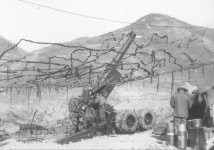LoboGunLeather
US Veteran
Like "Mr. Joe" mentioned above, I served as a Pathfinder, also with the 101st Airborne Division, but my experience came a bit later in Vietnam.
For those unfamiliar with the Pathfinders, our basic function was to secure a landing zone (LZ) prior to troop insertions, mark the preferred insertion points (smoke, flares, panels), then perform air traffic control for helicopters inserting troops, resupply, and medi-vac operations during the operation. Usually the Pathfinder teams were the first guys to go in and the last guys to leave.
I recall being inserted one night in preparation for a troop insertion the next day, and we found ourselves unable to orient ourselves by map to the terrain features in the area. Simply put, we had been dropped off miles from the intended LZ. Our field radio (PRC-25) was barely able to make contact with another unit, who relayed our problem to our HQ staff. After a few hours we were told to watch for impact on hilltops, identified by number and shown on our map. A Navy ship fired spotting rounds at hilltops, then waited to see if we could identify the impact. It took a couple of hours as the Navy sent round after round (probably a dozen or more) before we finally saw a hit several miles away. Another shot went to another hilltop and that allowed us to triangulate our position. A time consuming process, especially with the radio relay for message back and forth, and one round at a time fired by the Navy.
We were so far from the planned LZ that the operation was cancelled and we were extracted that night.
I don't know which Navy ship or what type of gun, but I do know that we were at least 15 miles inland from the South China Sea. Of course, we were sitting on a hilltop to provide enough visibility to the surrounding hills, so it was lucky that "our hill" hadn't been selected for a spotting round before we were able to figure out our location.
I think about that little incident frequently while using my GPS to guide me around an unfamiliar area. I expect modern technology has made a lot of difference for the guys doing that work today!
For those unfamiliar with the Pathfinders, our basic function was to secure a landing zone (LZ) prior to troop insertions, mark the preferred insertion points (smoke, flares, panels), then perform air traffic control for helicopters inserting troops, resupply, and medi-vac operations during the operation. Usually the Pathfinder teams were the first guys to go in and the last guys to leave.
I recall being inserted one night in preparation for a troop insertion the next day, and we found ourselves unable to orient ourselves by map to the terrain features in the area. Simply put, we had been dropped off miles from the intended LZ. Our field radio (PRC-25) was barely able to make contact with another unit, who relayed our problem to our HQ staff. After a few hours we were told to watch for impact on hilltops, identified by number and shown on our map. A Navy ship fired spotting rounds at hilltops, then waited to see if we could identify the impact. It took a couple of hours as the Navy sent round after round (probably a dozen or more) before we finally saw a hit several miles away. Another shot went to another hilltop and that allowed us to triangulate our position. A time consuming process, especially with the radio relay for message back and forth, and one round at a time fired by the Navy.
We were so far from the planned LZ that the operation was cancelled and we were extracted that night.
I don't know which Navy ship or what type of gun, but I do know that we were at least 15 miles inland from the South China Sea. Of course, we were sitting on a hilltop to provide enough visibility to the surrounding hills, so it was lucky that "our hill" hadn't been selected for a spotting round before we were able to figure out our location.
I think about that little incident frequently while using my GPS to guide me around an unfamiliar area. I expect modern technology has made a lot of difference for the guys doing that work today!



